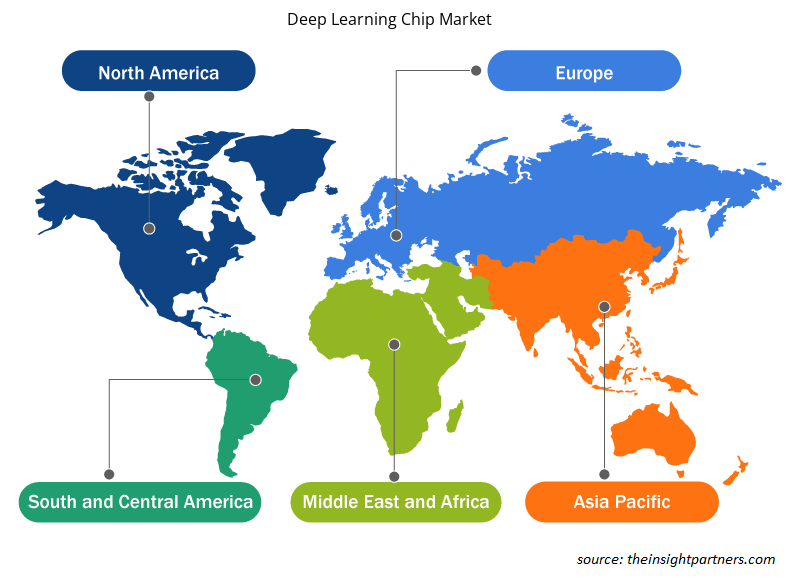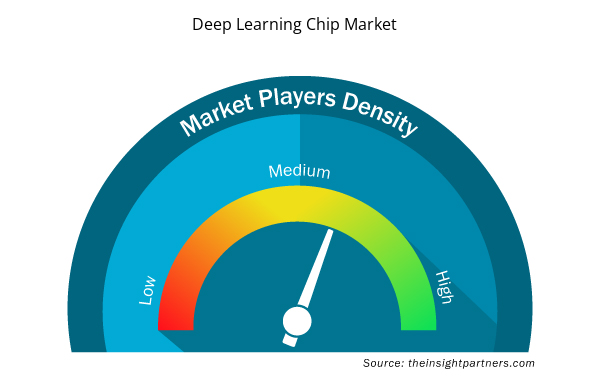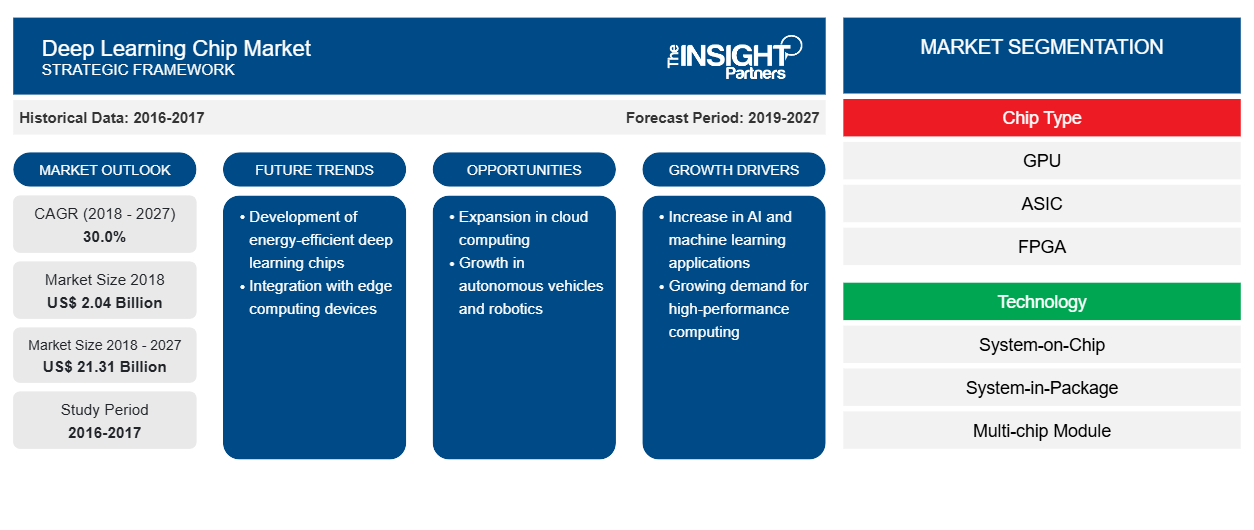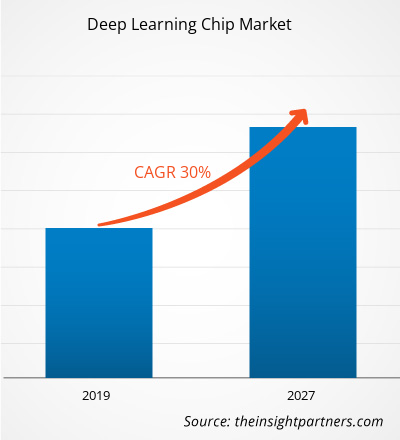글로벌 딥러닝 칩 시장 규모는 2018년에 20억 4 천만 달러 에 달했으며, 2019년~2027년 예측 기간 동안 연평균 성장률 30.0%로 성장해 2027년에는 213억 1 천만 달러 에 달할 것으로 예상됩니다 .
북미는 글로벌 딥 러닝 칩 시장을 선도하고 있으며, 예측 기간 내내 가장 높은 수익 기여자가 될 것으로 예상됩니다. 딥 러닝 칩 개발은 엄청난 양의 생성된 데이터에서 패턴을 개발하기 위한 기술 거인의 대규모 투자로 뒷받침됩니다. 양자 컴퓨팅의 부상과 로봇 공학에서 딥 러닝 칩의 구현은 북미 국가의 딥 러닝 칩 시장 성장을 주도하고 있습니다.
시장 통찰력
양자 컴퓨팅의 중요성이 딥러닝 칩 시장 성장에 기여
양자 컴퓨팅은 그렇지 않으면 더 많은 시간이 걸리는 계산을 완료하는 데 몇 초가 걸립니다. 양자 컴퓨터는 인공 지능, 머신 러닝 및 빅 데이터의 혁신적인 변형입니다. 따라서 양자 컴퓨팅의 두드러짐은 딥 러닝 칩 시장의 성장을 촉진할 것으로 예상됩니다. 또한 양자 컴퓨팅은 포트폴리오 최적화, 사기 탐지 및 위험 관리를 포함한 다양한 요소와 즉각적인 데이터 피드백이 필요한 영역에 유익합니다. 따라서 단일 프로세서가 몇 초 만에 복잡한 계산을 수행하는 것이 더 쉽습니다. 또한 인터넷 의 규모와 크기로 인해 딥 러닝은 매우 낮은 비용으로 대규모 데이터 세트를 유지하는 데 도움이 됩니다. 따라서 이러한 요소는 글로벌 딥 러닝 칩 시장 의 성장을 촉진할 것으로 예상됩니다.
귀하의 요구 사항에 맞게 이 보고서를 사용자 정의하세요
이 보고서의 일부 또는 국가 수준 분석, Excel 데이터 팩을 포함하여 모든 보고서에 대한 사용자 정의를 무료로 받을 수 있으며 신생 기업 및 대학을 위한 훌륭한 혜택과 할인 혜택을 이용할 수 있습니다.
- 이 보고서의 주요 시장 동향을 알아보세요.이 무료 샘플에는 시장 동향부터 추정 및 예측까지 다양한 데이터 분석이 포함됩니다.
실시간 소비자 행동 통찰력과 향상된 운영 효율성으로 딥 러닝 칩 시장의 전반적인 성장을 촉진합니다.
사업의 본질은 매우 경쟁적이 되고 있으며, 효율적으로 경쟁하기 위해 오늘날 기업은 유용한 정보와 사업 분석에 의존합니다. 전통적으로 사업 분석 도구는 일주일 또는 한 달 전의 이벤트에 대한 데이터에서 매출을 예측하는 데 사용되었습니다. 실시간으로 학습하고 패턴에 따라 권장 사항을 제공하는 인공 지능 기술의 출현으로 기업은 다양한 프로세스에 딥 러닝을 적용하여 사업 환경과 고객을 더 잘 이해할 수 있는 엄청난 기회를 얻었습니다.
이러한 요소를 고려할 때, 인공지능은 기업의 운영 효율성을 개선하고, 운영 비용을 낮추고, 서비스 품질과 고객 경험을 향상하는 데 도움이 됩니다.
칩 유형 통찰력
그래픽 처리 장치(GPU)는 2018년에 주요 딥 러닝 칩 시장 점유율을 차지한 반면, ASIC(Application-Specific Integrated Circuits)는 예측 기간 동안 가장 빠르게 성장하는 부문이 될 것으로 예상됩니다. ASIC은 매우 구체적이고 덜 유연하지만 인공 지능 애플리케이션에 사용할 수 있는 가장 성능이 뛰어난 하드웨어 옵션 중 하나이기 때문입니다.
기술 통찰력
딥 러닝 칩셋에는 시스템 온 칩, 시스템 인 패키지, 멀티 칩 모듈 등이 있으며, 기타 칩셋도 있습니다. 시스템 온 칩 부문은 2018년에 주요 딥 러닝 칩 시장 점유율을 차지했는데, 이는 에너지 낭비, 대형 시스템이 차지하는 공간, 비용을 줄이는 데 도움이 되기 때문입니다.
산업 수직 통찰력
글로벌 딥 러닝 칩 시장은 BFSI, 리테일, IT & 텔레콤, 자동차 & 운송, 헬스케어, 미디어 & 엔터테인먼트, 기타로 분류됩니다. BFSI는 딥 러닝 칩 시장에서 주요 시장 점유율을 차지한 반면, 헬스케어는 시장에서 가장 빠르게 성장하는 부문이 될 것으로 예상됩니다. 운영 비용 절감, 변화하는 규정 준수 및 규제에 적응, 핵심 사업에 집중, 비즈니스 프로세스에 자동화 통합과 같은 요인은 딥 러닝 칩 시장에서 BFSI 부문의 성장을 촉진하는 다른 주요 요인입니다.
딥 러닝 칩 시장에 있는 시장 참여자들은 주로 첨단 기술을 구현하여 제품 개선에 집중하고 있습니다. 파트너십, 계약, 합작 투자, 자금 조달, 전 세계에 새로운 사무실을 개설함으로써 회사는 전 세계적으로 브랜드 이름을 유지할 수 있습니다. 최근 개발 사항 중 몇 가지는 다음과 같습니다.
2019년: NVIDIA는 Hackster.io와 협력하여 AI at the Edge Challenge를 시작했습니다. 이는 개발자들이 NVIDIA Jetson Nano 개발자 키트를 사용하여 창의적이고 독특한 프로젝트를 구축하고 10만 달러의 상금을 얻을 수 있는 대회입니다.
2019: 인텔은 7nm 칩을 생산하기 위해 오리건 공장을 확장할 계획이라고 발표했습니다. 인텔의 새로운 공장은 인텔이 2010년에 시작한 대규모 공장인 D1X의 3단계가 될 것입니다. 처음 두 단계는 각각 110만 제곱피트 규모로, Costco 창고 매장 15개에 해당하는 시설을 합친 규모입니다. 3단계에서는 D1X의 제조 공간이 약 50% 늘어날 것으로 보입니다. 또한 인텔은 공장 확장을 통해 칩 부족에 60% 더 빠르게 대응할 수 있을 것이라고 밝혔습니다.
2019: Huawei는 업계 최초의 T-레벨 AIFW인 HiSecEngine USG12000을 출시했습니다. HiSecEngine USG12000은 Ascend AI 칩을 탑재하여 기업 네트워크를 위한 지능형 탐지 기능과 지능형 국경 방어 기능을 제공합니다.
딥러닝 칩 시장 지역 통찰력
Insight Partners의 분석가들은 예측 기간 동안 딥 러닝 칩 시장에 영향을 미치는 지역적 추세와 요인을 철저히 설명했습니다. 이 섹션에서는 북미, 유럽, 아시아 태평양, 중동 및 아프리카, 남미 및 중미의 딥 러닝 칩 시장 세그먼트와 지리에 대해서도 설명합니다.

- 딥러닝 칩 시장을 위한 지역별 데이터 얻기
딥러닝 칩 시장 보고서 범위
| 보고서 속성 | 세부 |
|---|---|
| 2018년 시장 규모 | 20억 4천만 달러 |
| 2027년까지 시장 규모 | 213억 1천만 달러 |
| 글로벌 CAGR (2018-2027) | 30.0% |
| 역사적 데이터 | 2016-2017 |
| 예측 기간 | 2019-2027 |
| 다루는 세그먼트 | 칩 유형별
|
| 포함된 지역 및 국가 | 북아메리카
|
| 시장 선도 기업 및 주요 회사 프로필 |
|
시장 참여자 밀도: 비즈니스 역학에 미치는 영향 이해
딥 러닝 칩 시장은 소비자 선호도의 변화, 기술 발전, 제품의 이점에 대한 인식 증가와 같은 요인으로 인해 최종 사용자 수요가 증가함에 따라 빠르게 성장하고 있습니다. 수요가 증가함에 따라 기업은 제품을 확장하고, 소비자의 요구를 충족하기 위해 혁신하고, 새로운 트렌드를 활용하여 시장 성장을 더욱 촉진하고 있습니다.
시장 참여자 밀도는 특정 시장이나 산업 내에서 운영되는 회사나 기업의 분포를 말합니다. 주어진 시장 공간에 얼마나 많은 경쟁자(시장 참여자)가 존재하는지 그 규모나 전체 시장 가치에 비해 나타냅니다.
딥 러닝 칩 시장에서 활동하는 주요 기업은 다음과 같습니다.
- 어드밴스드 마이크로 디바이시스 주식회사
- 알파벳 주식회사(Google)
- Amazon.com 주식회사
- 바이두 주식회사
- 화웨이 테크놀로지 주식회사
면책 조항 : 위에 나열된 회사는 어떤 특별한 순서에 따라 순위가 매겨지지 않았습니다.

- 딥러닝 칩 시장의 주요 기업 개요를 알아보세요
글로벌 딥러닝 칩 시장 세분화
칩 유형별
- 그래픽 카드
- ASIC
- FPGA
- CPU
- 기타
기술로
- 시스템 온 칩
- 시스템 인 패키지
- 멀티칩 모듈
- 기타
산업별 수직별
- 미디어 및 광고
- BFSI, IT 및 통신
- 소매
- 헬스케어
- 자동차 및 운송
- 기타
지리별로
북아메리카
- 우리를
- 캐나다
- 멕시코
유럽
- 프랑스
- 독일
- 영국
- 러시아 제국
- 이탈리아
- 유럽의 나머지 지역
아시아 태평양(APAC)
- 호주
- 중국
- 인도
- 일본
- 대한민국
- APAC의 나머지 지역
중동 및 아프리카(MEA)
- 사우디 아라비아
- 남아프리카 공화국
- 아랍에미리트
- MEA의 나머지
남미(SAM)
- 브라질
- 아르헨티나
- SAM의 나머지
회사 프로필
- 어드밴스드 마이크로 디바이시스 주식회사
- 알파벳 주식회사(Google)
- Amazon.com 주식회사
- 바이두 주식회사
- 화웨이 테크놀로지 주식회사
- 인텔 코퍼레이션
- 엔비디아 코퍼레이션
- 퀄컴 주식회사
- 삼성전자(주)
- 주식회사 자일링스
- 역사적 분석(2년), 기준 연도, CAGR을 포함한 예측(7년)
- PEST 및 SWOT 분석
- 시장 규모 가치/양 - 글로벌, 지역, 국가
- 산업 및 경쟁 환경
- Excel 데이터 세트


- Virtual Pipeline Systems Market
- Thermal Energy Storage Market
- Intraoperative Neuromonitoring Market
- Ketogenic Diet Market
- Mail Order Pharmacy Market
- Emergency Department Information System (EDIS) Market
- Small Satellite Market
- Dropshipping Market
- Sports Technology Market
- Sterilization Services Market

Report Coverage
Revenue forecast, Company Analysis, Industry landscape, Growth factors, and Trends

Segment Covered
This text is related
to segments covered.

Regional Scope
North America, Europe, Asia Pacific, Middle East & Africa, South & Central America

Country Scope
This text is related
to country scope.
자주 묻는 질문
The BFSI industry dominated the deep learning chip market in the year 2018. Banking, financial services, and insurance (BFSI) industries have great potential for deep learning chips due to the presence of huge financial and personal data of customers. In this sector, a high amount of sensitive data is generated and exchanged every day. There is growing volume and creation of endpoints and mobile devices in banks, credit card companies, and credit reporting institutions, thus, it becomes important for these industry verticals to harness this data to gain insights about various business aspects.
Presently, the major applications of deep learning chips are in the data center/cloud computing segment, and this trend is expected to continue during the forecast period. Also, majorly due to rising adoption of AI in developing regions, evolving architectures of deep learning chips and increasing applications across various industry verticals. Owing to this growing trend, the companies are anticipated to produce high-quality service by adopting cloud-based artificial intelligence services.
North America is one of the fastest-growing regions in terms of technological development. In the past 3 years, the region witnessed significant adoption of AI solutions across all the sectors. North America contributes the largest market share in terms of revenue, and it is estimated that it will continue its dominance in the market share during the forecast period. Deep learning chip development is backed by large-scale investment from technological giants to develop patterns from huge amount of generated data. The rise of quantum computing and implementation of deep learning chips in robotics drive the growth of the deep learning chip market in the North American countries.
Trends and growth analysis reports related to Electronics and Semiconductor : READ MORE..
The List of Companies - Deep Learning Chip Market
- Advanced Micro Devices, Inc.
- Alphabet Inc. (Google)
- Amazon.com, Inc.
- Baidu, Inc.
- Huawei Technologies Co., Ltd
- Intel Corporation
- NVIDIA Corporation
- Qualcomm Incorporated
- Samsung Electronics Co., Ltd.
- Xilinx, Inc.
The Insight Partners performs research in 4 major stages: Data Collection & Secondary Research, Primary Research, Data Analysis and Data Triangulation & Final Review.
- Data Collection and Secondary Research:
As a market research and consulting firm operating from a decade, we have published and advised several client across the globe. First step for any study will start with an assessment of currently available data and insights from existing reports. Further, historical and current market information is collected from Investor Presentations, Annual Reports, SEC Filings, etc., and other information related to company’s performance and market positioning are gathered from Paid Databases (Factiva, Hoovers, and Reuters) and various other publications available in public domain.
Several associations trade associates, technical forums, institutes, societies and organization are accessed to gain technical as well as market related insights through their publications such as research papers, blogs and press releases related to the studies are referred to get cues about the market. Further, white papers, journals, magazines, and other news articles published in last 3 years are scrutinized and analyzed to understand the current market trends.
- Primary Research:
The primarily interview analysis comprise of data obtained from industry participants interview and answers to survey questions gathered by in-house primary team.
For primary research, interviews are conducted with industry experts/CEOs/Marketing Managers/VPs/Subject Matter Experts from both demand and supply side to get a 360-degree view of the market. The primary team conducts several interviews based on the complexity of the markets to understand the various market trends and dynamics which makes research more credible and precise.
A typical research interview fulfils the following functions:
- Provides first-hand information on the market size, market trends, growth trends, competitive landscape, and outlook
- Validates and strengthens in-house secondary research findings
- Develops the analysis team’s expertise and market understanding
Primary research involves email interactions and telephone interviews for each market, category, segment, and sub-segment across geographies. The participants who typically take part in such a process include, but are not limited to:
- Industry participants: VPs, business development managers, market intelligence managers and national sales managers
- Outside experts: Valuation experts, research analysts and key opinion leaders specializing in the electronics and semiconductor industry.
Below is the breakup of our primary respondents by company, designation, and region:

Once we receive the confirmation from primary research sources or primary respondents, we finalize the base year market estimation and forecast the data as per the macroeconomic and microeconomic factors assessed during data collection.
- Data Analysis:
Once data is validated through both secondary as well as primary respondents, we finalize the market estimations by hypothesis formulation and factor analysis at regional and country level.
- Macro-Economic Factor Analysis:
We analyse macroeconomic indicators such the gross domestic product (GDP), increase in the demand for goods and services across industries, technological advancement, regional economic growth, governmental policies, the influence of COVID-19, PEST analysis, and other aspects. This analysis aids in setting benchmarks for various nations/regions and approximating market splits. Additionally, the general trend of the aforementioned components aid in determining the market's development possibilities.
- Country Level Data:
Various factors that are especially aligned to the country are taken into account to determine the market size for a certain area and country, including the presence of vendors, such as headquarters and offices, the country's GDP, demand patterns, and industry growth. To comprehend the market dynamics for the nation, a number of growth variables, inhibitors, application areas, and current market trends are researched. The aforementioned elements aid in determining the country's overall market's growth potential.
- Company Profile:
The “Table of Contents” is formulated by listing and analyzing more than 25 - 30 companies operating in the market ecosystem across geographies. However, we profile only 10 companies as a standard practice in our syndicate reports. These 10 companies comprise leading, emerging, and regional players. Nonetheless, our analysis is not restricted to the 10 listed companies, we also analyze other companies present in the market to develop a holistic view and understand the prevailing trends. The “Company Profiles” section in the report covers key facts, business description, products & services, financial information, SWOT analysis, and key developments. The financial information presented is extracted from the annual reports and official documents of the publicly listed companies. Upon collecting the information for the sections of respective companies, we verify them via various primary sources and then compile the data in respective company profiles. The company level information helps us in deriving the base number as well as in forecasting the market size.
- Developing Base Number:
Aggregation of sales statistics (2020-2022) and macro-economic factor, and other secondary and primary research insights are utilized to arrive at base number and related market shares for 2022. The data gaps are identified in this step and relevant market data is analyzed, collected from paid primary interviews or databases. On finalizing the base year market size, forecasts are developed on the basis of macro-economic, industry and market growth factors and company level analysis.
- Data Triangulation and Final Review:
The market findings and base year market size calculations are validated from supply as well as demand side. Demand side validations are based on macro-economic factor analysis and benchmarks for respective regions and countries. In case of supply side validations, revenues of major companies are estimated (in case not available) based on industry benchmark, approximate number of employees, product portfolio, and primary interviews revenues are gathered. Further revenue from target product/service segment is assessed to avoid overshooting of market statistics. In case of heavy deviations between supply and demand side values, all thes steps are repeated to achieve synchronization.
We follow an iterative model, wherein we share our research findings with Subject Matter Experts (SME’s) and Key Opinion Leaders (KOLs) until consensus view of the market is not formulated – this model negates any drastic deviation in the opinions of experts. Only validated and universally acceptable research findings are quoted in our reports.
We have important check points that we use to validate our research findings – which we call – data triangulation, where we validate the information, we generate from secondary sources with primary interviews and then we re-validate with our internal data bases and Subject matter experts. This comprehensive model enables us to deliver high quality, reliable data in shortest possible time.


 이 보고서에 대한 무료 샘플을 받으세요
이 보고서에 대한 무료 샘플을 받으세요